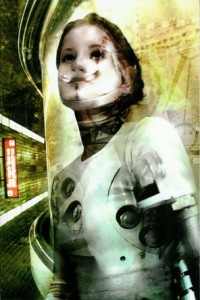I wrote the first draft of The Holy Machine a long time ago, back in 1994, under the growing shadow of the conflict whose iconic moment – at least in the West – was to be the destruction of the World Trade Centre in 2001. (It had also been attacked in 1993).
This conflict is often portrayed as a conflict between radical Islam and the West, but I saw it as being between secularism and traditional religious authority. (The protestant zealots in the US who burn the Koran, and carry placards reading ‘God Hates Fags’ have much more in common with the Taliban than they do with secular modernity, or even with more modern less literal versions of Christianity.) I went on to imagine how secular modernity, when under threat, might itself morph into a kind of intolerant fundamentalist atheism.
The story deals with (a) a paralysingly shy young man, George, who tries to persuade himself that his feelings about a robot sex toy are really love, (b) the robot itself, Lucy, which begins to become aware of itself, and (c) George’s traumatised mother, Ruth, who hides away in virtual reality rather than go out and face the day. The thematic link between these foreground stories and the background conflict, the thread with which I sewed them all together, comes from a series of related or analogous dichotomies: religion/science, mind/matter, body/spirit, semblance/reality (and perhaps also love/sex).

I completed the book pretty much its present form in 1997. The small press Big Engine was going to publish it, but then went out of business (after some useful editorial input from Ben Jeapes). The US small press Wildside then took it over and published a print-on-demand version (with a very striking cover image by Wilhelm Steiner) in 2004. Dorchester books produced a mass market paperback US edition under the Cosmos imprint in 2009. The new revised edition from Corvus finally came out in 2010, following my success with The Turing Test, 16 years after I wrote the first draft of the book. (A German translation, Messias-Maschine, followed in 2012.)
Not everyone likes this book – the main character is not exactly the regular hero type, and some of his behaviour is pretty creepy – but some people seem to like it a lot. ‘The most amazing book I have ever read..,’ wrote one enthusiastic reader on US Amazon, God bless him, ‘A must read for all human beings!’